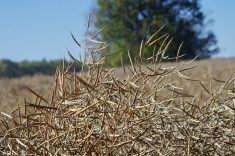To those less familiar with charting and technical analysis, the recent drop in oat prices may have come as a bit of a surprise.
What I have found in my 30 years’ experience is that even though the oat futures market has a relatively small amount of open interest compared to actively traded commodities such as corn, the oat market consistently provides reversal patterns and chart formations that are second-to-none.
Veteran traders will tell you "oats leads the way."
One of the biggest mistakes novice traders make is to buy the weaker grain (in this case, oats), believing it to be undervalued and expecting it to gain on the stronger grain (corn), when there is good reason for the weaker commodity to be priced where it is.
Read Also

U.S. livestock: Cattle futures surge as second screwworm case announced
Chicago | Reuters – Chicago Mercantile Exchange cattle futures rallied on Friday as two new screwworm cases were announced in…
The benefit of relying on charts is it removes the innate emotion we all have, and cuts through the news.
Understanding the psychology of the market allows you to understand the dynamics involved, especially as it pertains to human emotion and the flow of money. To a technical analyst, understanding that long liquidation was responsible for the recent collapse of the oat market is reason enough.
As illustrated in the accompanying chart, there were tell-tale signals (warning signs) prior to each of the oat market’s four downturns. Two-day reversals (points 1 to 4) occurred at the top of each successive rally, which provided farmers with timely sell signals.
In fact, the most recent sell signal (two-day reversal; point 4) occurred just before the completion of a head + shoulders top.
Head + shoulders top
Of all the patterns that form on a chart, the head + shoulders top is considered the most reliable. The main importance is that it indicates a reversal of the trend.
The head + shoulders top is composed of three successive price advances, with the second rally reaching a higher level than either of the other two.
The left shoulder (point A), or first rally, normally marks the end of a substantial price rise. A reaction (decline) then occurs.
A second rally follows, which will exceed the price level of the first. This forms the head (point B).
The second price reaction should culminate at approximately the same price level as the first decline and always below the top of the left shoulder.
The right shoulder (point C), or third rally, follows. It fails to reach the second rally’s high (the head). The volume on the right shoulder should be less than that of either the left shoulder or head.
Market psychology: On the advance forming the left shoulder, the shorts are on the run buying back their positions, while longs begin selling to take profits. Resultant trading activity is very heavy. As the buying and selling subside, the market undergoes a normal correction.
This downward movement of prices attracts buyers and prices start moving up again. When prices on this upward leg surpass the peak reached by the left shoulder, buyers who not only missed the preceding bull move, but also the opportunity to buy during the first decline, jump in. This advance forms the head.
A surge of buying climaxes at the head and the second decline begins. The second reaction runs its course and prices begin to move up for the third and final time.
During the third price advance, it will appear to the longs who are suffering losses that the market is going to bail them out, but right-shoulder highs tend to fall far short of expectations.
Never seeing their positions move into the plus column on the third and final advance unnerves the longs. As prices complete the right shoulder and begin to decline, these longs become willing sellers in order to limit losses.
The head + shoulders top is completed when the price penetrates the neckline (point D) — a line connecting the bottoms of the two reactions.
Sell stops are triggered below the neckline, and the ensuing long liquidation causes prices to plummet.
Send us your questions or comments about this article and chart.
— David Drozd is president and senior market analyst for Winnipeg-based Ag-Chieve Corp. The opinions expressed are those of the writer and are solely intended to assist readers with a better understanding of technical analysis. Visit Ag-Chieve online for information about grain marketing advisory services, or call us toll-free at 1-888-274-3138 for a free consultation.














